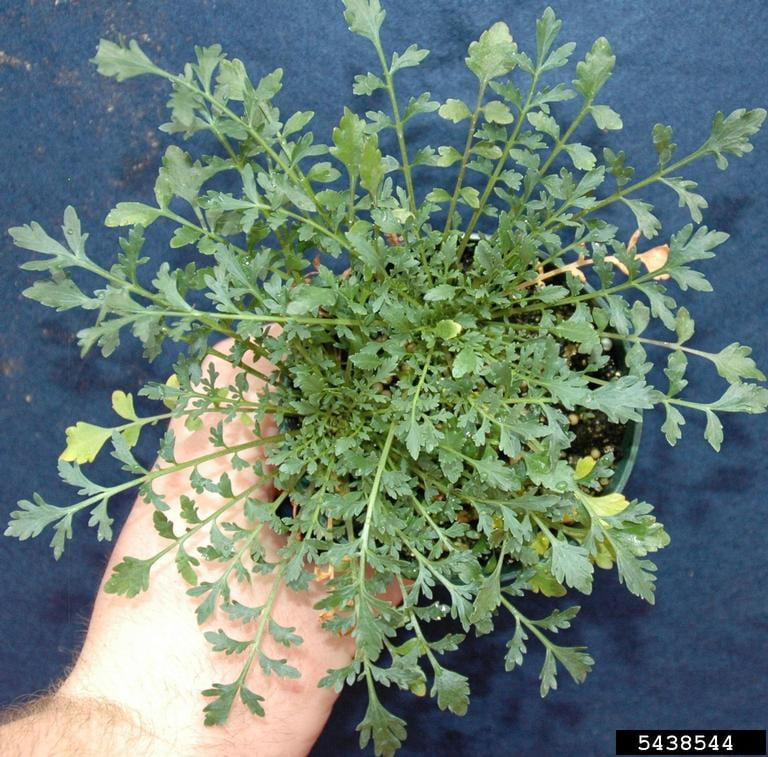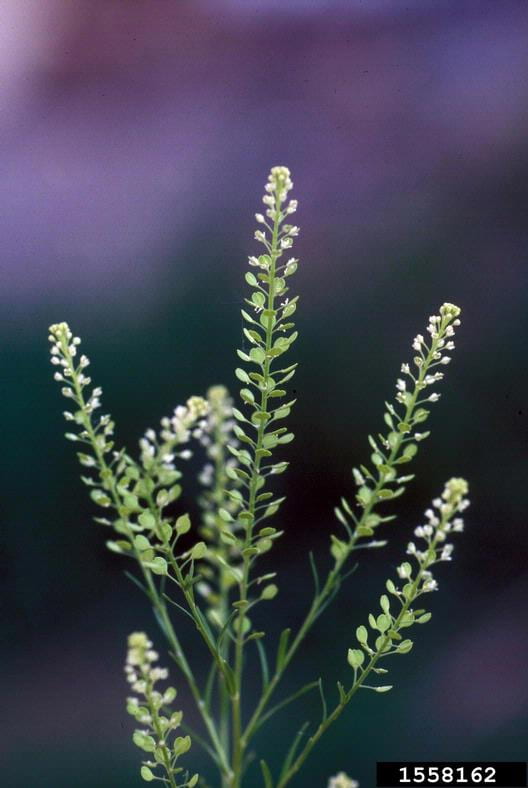Virginia pepperweed (Lepidium virginicum) is a weedy mustard of most agricultural crops and disturbed areas. In New York, it is usually a winter annual, but sometimes acts as a summer annual or biennial. All parts of the plant have a peppery taste.
Virginia pepperweed is one of 3000+ species in the mustard family. For help identifying weedy mustards either in the rosette or flowering phase, please visit our mustard identification page.
Identification
Seedlings: Cotyledons are 7-10 (up t0 2/5”) mm long by 2-3 mm (~1/10”) wide, hairless, and oval-shaped with long petioles. The first 2 leaves that emerge grow opposite each other, while subsequent leaves are alternate and form a basal rosette. Seeding leaves are oval-shaped with long petioles, toothed margins, and hairs on the upper surface, undersides of veins, and leaf margins. Later rosette leaves become smooth on the upper surface, with irregular lobes that reach the midrib of the leaf.
Leaves: Leaves toward the base of the plant lack hairs and are oval to oblong. These lower leaves are pinnately lobed and have toothed margins. The basal leaves do not persist on the mature plant. Leaves towards the upper portion of the plant are smaller, have no petiole (the leaf extends to the plant stem), are pointed at the tip and taper towards the stem, and can have toothed or entire margins.
View from above of virginia pepperweed basal leaves.
Photo by Bruce Ackley of The Ohio State University via Bugwood.org
Mature plant: Stems are branched and contain tiny hairs on the surface. Flowers emerge in May and are present consistently until early summer and sporadically until autumn.
Flowers: First flowers are in a cluster, but as the season progresses the flowering stem extends, with seeds forming lower on the stem while flowers bloom towards the top. Each flower has 4 white to greenish petals and 2 stamens.
Virginia pepperweed flowers
Photo by Ohio State Weed Lab of The Ohio State University via Bugwood.org
Fruit: The fruit are rounded and flattened seedpods (silicles) that are slightly winged and notched at the apex, the fruit is 2.5-4 (up t0 4/25”) mm wide. Virginia pepperweed seeds are 1.5 mm (1/20”) long, oval, and light brown with a peppery taste. One side of the seed is straight and flat while the other is rounded and winged.

Virginia pepperweed fruit
Photo by D. Walters and C. Southwich of Table Grape Weed Disseminule ID via Bugwood.org
Management
Chemical control
New York specific guidance can be found in the Cornell Crop and Pest Management Guides, or click below for chemical control options for virginia pepperweed from Cornell’s turfgrass and weed weed identification app.
While Virginia pepperweed herbicide resistance has not been documented in the US, it developed resistance to Group 22 (paraquat) herbicides in Ontario, CA.
Non-chemical control
Virginia pepperweed is a typical winter annual, and can be managed with normal control practices for winter annual weeds.
Species Similar to Virginia Pepperweed
Table 1: Shows virginia pepperweed (Lepidium campestre) similarities and differences in identification compared to its similar species .| Species | Similarities | Differences |
|---|---|---|
| Field pepperweed (Lepidium campestre) | white to greenish flowers in groups of 4 petals, alternate leaves, simple to partially toothed leaf margins | hairless leaves, leaves clasp the stem |
References
Uva R H, Neal J C, DiTomaso J M. 1997. Weeds of the Northeast. Book published by Cornell University, Ithaca NY. The go-to for weed ID in the Northeast; look for a new edition sometime in 2019.
Cornell University’s Turfgrass and Landscape Weed ID app. Identification and control options for weeds common to turf, agriculture, and gardens in New York; uses a very simple decision tree to identify your weed.
A Mustard Identification Workshop by Tim Miller of Washington State University via the Washington State Weed Conference. Identification page for mustards.
International Herbicide-Resistant Weed Database, which provides documentation of herbicide resistant weed populations from around the world. Accessed Sept 4 2020.









